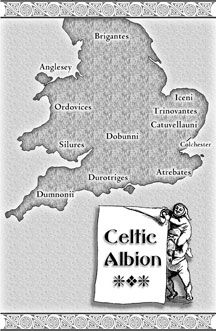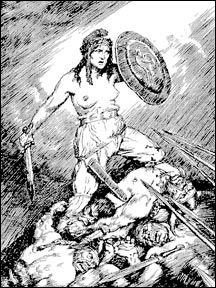| Boudicca’s
War
By Mike Bennighof, Ph.D.
March 2018
 How can a Briton be called Good? How can a Briton be called Good?
Drunk would be a better name.
—Ausonius
In the year 58, seven years after Roman armies
subdued resistance in the new province of
Britannia, the island’s third Roman
governor, Paulinius Suetonius, arrived to
take command. Suetonius had an excellent military
reputation, but took over a province that
seethed with unrest.
Suetonius, probably correctly, saw the Druidic
religion as the source of this discontent.
During his last assignment, in what is now
Morocco, he had led his troops into the wild
Atlas mountains to destroy rebels’ training
grounds and sources of supply. He now proposed
to do the same thing in Britannia, slashing
through what is now Wales to crush the Druidic
center on the island of Mona (modern Anglesey).
In early 60 his expedition set out.
On the other side of the island, Queen Boudicca
of the Iceni took the opportunity to unleash
a massive revolt against the Romans. The Iceni
lived in what today is East Anglia. They had
made peace with the Romans soon after the
invasion of 43, becoming a client kingdom
and establishing profitable trade. But in
48 the new governor, Ostorius Scapula, redrew
the boundaries of nearby tribes and offended
the Iceni. They, like other tribes, had also
been forced to take out large loans they did
not want from prominent Roman citizens, at
high interest rates. When the lenders called
their loans, Roman officials used force to
exact payment. The infuriated Iceni rose in
revolt, but the Romans put them down with
the aid of other client tribes including the
powerful Brigantes. Afterward they installed
a new, more pliable client king of the Iceni
named Presutagus.
 The
exact relationship between Presutagus and
his wife, Boudicca, is not clear today. Roman
references to her as “from the royal
house” and the devotion shown to her
by the Iceni warrior class imply that she
was no mere consort but may have held the
queenship by birthright, with Presutagus imposed
on her by the Romans as their agent. This
would go far to explain her violent reaction
when Presutagus died and Roman officials tried
to exert a claim of inheritance. The
exact relationship between Presutagus and
his wife, Boudicca, is not clear today. Roman
references to her as “from the royal
house” and the devotion shown to her
by the Iceni warrior class imply that she
was no mere consort but may have held the
queenship by birthright, with Presutagus imposed
on her by the Romans as their agent. This
would go far to explain her violent reaction
when Presutagus died and Roman officials tried
to exert a claim of inheritance.
“In stature she was very tall,”
the Roman historian Dio Cassius wrote of Boudicca.
“In appearance most terrifying, in the
glance of her eye most fierce, and her voice
was harsh; a great mass of the tawniest hair
fell to her hips; around her neck was a large
golden necklace; and she wore a tunic of diverse
colors over which a thick mantle was fastened
with a brooch. This was her invariable attire.”
Standard Roman practice was to force client
kings to put Rome in their wills, often as
joint ruler with the king’s heirs. Presutagus’
rights appear to have been disputed, with
Boudicca asserting that his death did not
change the client relationship, while low-ranking
Roman officials said otherwise. A group of
Roman centurions and slaves stripped Boudicca
to the waist and whipped her, then raped her
teenage daughters as she watched. They also
carried off several of her relatives and sold
them in the slave market at Colchester.
Boudicca did not immediately call on her
people to rise against the Romans, however,
hinting that she waited for Suetonius to leave
on his expedition into Wales. When she did
make the call, she was surrounded by a bodyguard
of black-clad Wild Women, the highly-trained
female warriors who guarded the Druids’
sacred oak groves.
The Roman historian Tacitus attributes to
Boudicca a speech in which she says that,
“Though a woman, my resolution is fixed.
The men, if they please, may survive with
infamy and live in bondage.” Tacitus
of course was not present, and the convention
of the day was to invent dialogue. The reaction
of the Iceni and their allies shows that they
had no problem following a woman into battle:
At least 80,000 warriors rallied behind her.
 Modern
writers have made much of Boudicca’s
gender, but Celtic warriors would willingly
follow a woman into battle. Celts expected
their leaders to lead, and a queen ceding
that role to a male general would also be
handing over her political power. Few Celtic
women took up arms other than the Wild Women,
a highly educated warrior society so-called
for their fury in battle. But Celtic queens
did indeed fight, more often in Britannia
than on the continent, and only a few years
before Queen Cartimandua of the Brigantes
had faced her ex-husband in battle. Modern
writers have made much of Boudicca’s
gender, but Celtic warriors would willingly
follow a woman into battle. Celts expected
their leaders to lead, and a queen ceding
that role to a male general would also be
handing over her political power. Few Celtic
women took up arms other than the Wild Women,
a highly educated warrior society so-called
for their fury in battle. But Celtic queens
did indeed fight, more often in Britannia
than on the continent, and only a few years
before Queen Cartimandua of the Brigantes
had faced her ex-husband in battle.
Boudicca apparently unleashed her warriors
before the spring planting, hoping to catch
the Romans by surprise and to force Suetonius
to abandon his attack on Mona. She definitely
succeeded in the first instance. Her army
quickly overran the Roman colony at Camulodunum.
The Romans huddled in the ostentatiously-decorated
Temple of Victory, where a handful of veterans
tried to make a stand. The colony had been
built on land confiscated from the Iceni after
the 48 rebellion, and the veterans’
arrogant behavior toward their Celtic neighbors
made them deeply hated.
The colony had no fortifications and the
defenders lost heart when the huge statue
of Victory purportedly tumbled over for no
apparent reason. The Iceni swept over the
disheartened defenders with ease. All of the
inhabitants were gleefully put to the sword
(or boiled alive, or run through with red-hot
irons, or crucified, or burned to death) except
for the upper-class Roman women. At Boudicca’s
direction they were stripped and impaled,
their breasts sliced off and sewn to their
mouths, all in honor of the Celtic war goddess
Andrasta, sometimes called the Morrigan.
Boudicca’s war crime was likely designed
to enrage the Romans and assure that Suetonius
would abandon his march on Mona, and it did
exactly that. Petilius Cerialis, left in charge
with the governor away on campaign, apparently
felt he had no choice but to bring the Iceni
to battle with his understrength Ninth Legion.
The Celts crushed the single legion, and went
on to sack the Roman colonies at Londinium
and Verulamium. At least 70,000 Roman civilians
were slaughtered by the Iceni and their allies,
as more and more tribes threw in their lot
with Boudicca, particularly their powerful
neighbors the Trinovantes. Cerialis escaped
to Gaul, and though Tactictus’ statement
that the entire legion “paid for their
rashness with their lives” is a poetic
overstatement, it was a serious defeat for
Rome and one that brought Boudicca large-scale
support.
 If
the queen’s gambit was intended to relieve
pressure on the Druids — there is no
direct evidence of this, but circumstances
point to it — she failed. Suetonius
had already mounted an amphibious assault
on Mona when word came of the Iceni revolt.
The Wild Women fought fanatically to defend
the groves and died to the last woman, while
Gangani and Deceangli warriors also put up
crazed resistance. Exiles from all over Britannia,
opposed to Roman rule, had gathered on the
island and Suetonius put the entire nest of
opposition to death. Having slaughtered the
Druids and their political allies, the Romans
finished the job by hacking down and burning
the ancient, sacred oak trees. If
the queen’s gambit was intended to relieve
pressure on the Druids — there is no
direct evidence of this, but circumstances
point to it — she failed. Suetonius
had already mounted an amphibious assault
on Mona when word came of the Iceni revolt.
The Wild Women fought fanatically to defend
the groves and died to the last woman, while
Gangani and Deceangli warriors also put up
crazed resistance. Exiles from all over Britannia,
opposed to Roman rule, had gathered on the
island and Suetonius put the entire nest of
opposition to death. Having slaughtered the
Druids and their political allies, the Romans
finished the job by hacking down and burning
the ancient, sacred oak trees.
The job had just been finished when Suetonius
ordered his legions, the XIV Gemina and XX
Valeria, to set out to face the Iceni. Finding
himself greatly outnumbered, Suetonius fell
back as the Celts razed settlement after settlement,
calling on the other remaining legion of the
garrison, II Augusta, to join him.
With the II Legion’s commanding general
refusing to march, Suetonius finally chose
what seemed good ground and turned to give
battle. Tacitus claims Suetonius had but 10,000
men to face 100,000 Celts, but then Suetonius
was after all his father-in-law so the numbers
need not be taken literally. Togidubnus of
the Atrebates, a long-time Roman client, may
have brought his warriors to fight alongside
the Romans, easing the odds more than Tactitus
admits. Boudicca went from tribe to tribe,
working them into the traditional battle-frenzy,
while Suetonius spoke to his own men of the
atrocities commited by the Celts and sneered
at the Wild Women surrounding the enemy leader.
After releasing a rabbit between the two
armies, Boudicca’s Celts led off the
battle with a massive charge of chariots,
which cluttered the battlefield and disorganized
the Celts far more than the Romans. The huge
numbers of the Britons worked against them,
and Suetonius sent his men forward in a tight
wedge, their stabbing swords doing great destruction
while the Celts could not find room to swing
their huge weapons. It was all over within
hours.
Tactitus claims almost 80,000 Celtic dead,
but admits this includes women and camp-followers
slaughtered by the Romans after the Celtic
warriors broke and implies that slaughtered
horses might be part of the total as well.
The Romans claimed to have suffered about
400 killed in action. Boudicca either drank
poison after the defeat or fell sick and died,
while her daughters disappeared. Her grave,
and the gold looted from the three destroyed
Roman cities, have never been found.
The Iceni came under direct Roman rule, unable
to carry on resistance without their charismatic
leader. By attacking before the spring planting,
Boudicca had launched a desperate gamble:
Having failed to capture Roman grain stocks,
the Iceni and their allies now starved. They
had little choice but to submit to the Romans.
Suetonius received no imperial congratulations
for his victory; Nero apparently believed
he should not have been caught by surprise
to begin with. At the first excuse he was
relieved of command and replaced by the former
consul Publius Petronius Turpilianus, who
forged an uneasy peace with the help of large-scale
legionary reinforcements dispatched from the
German frontier garrisons.
Boudicca’s final battle is the centerpiece
of our Rome at War: Queen
of the Celts game.
Click
here to order Queen of the Celts now!
Mike Bennighof is president of Avalanche Press and holds a doctorate in history from Emory University. A Fulbright Scholar and award-winning journalist, he has published over 100 books, games and articles on historical subjects.
He lives in Birmingham, Alabama with his wife, three children and his dog, Leopold. Leopold is faster than a rabbit.
|
